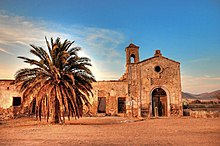Cortijo
A cortijo is a type of traditional rural dwelling (akin to the
Cortijos may have their origins in ancient Roman villas, for the word is derived from the Latin cohorticulum, a diminutive of cohors, meaning 'courtyard' or inner enclosure.[3] They are often isolated structures associated with a large family farm or livestock management in the adjoining lands.[4]
Description
A cortijo would usually include a large house, together with accessory buildings such as workers' quarters, sheds to house livestock, granaries, oil mills, barns and often a wall limiting the enclosure where there were no buildings surrounding it.[4] It was also common for isolated cortijos to include a small chapel.
In mountain areas, rough
The master of the cortijo or "señorito" would usually live with his family in a two-story building when visiting, while the accessory structures were for the labourers and their families —also known as "cortijeros".[2] The latter buildings were usually of more simple construction.[5]
The cortijo was usually a habitat surrounded by extensive lands, such as
Many cortijos became deserted following
Famous cortijos


- Cortijo de Arroyovil, where Francisco Franco used to overnight when hunting, near Mancha Real.[7]
- Cortijo de Miraflores, a historical building in Marbella.[8]
- Cortijo Jurado, near Campanillas; reputed to be haunted.[9]
- Cortijo de las Mezquitas, located between Antequera, Campillos and Sierra de Yeguas.[10]
- Cortijo de Alventu, located near río Guadalquivir.[11]
- Cortijo Bacardí, located in Málaga[12]
- Cortijo del Fraile, in Níjar municipality, known as the scene of a crime.[13]
- Cortijo de Aparicio el Grande
- Cortijo Cañaveral de los Frailes
- Albacete Province[14]
- El Cortijo, a nightclub in Barcelona.[citation needed]
- Francoist concentration camp where Spanish Republican military personnel were interned and where many were shot.[15] at the time of the Spanish Civil War.[16]
- Cortijo del Carmen and cortijo de San Patricio, in Gádor, scene of the crime of Gádor.[19][20]
See also
- Alquería
- Hacienda
References
- ISBN 9780252050596.
cortijo, or farmhouse (cortijo is a word common to Andalusia and Extremadura and means the same thing as finca in Castilian)
- ^ a b Alcalá Venceslada, Antonio (1999). Vocabulario Andaluz, El Mundo-Unidad Editorial, Barcelona, p. 173.
- ISBN 8476582382, p. 69. Google Books.
- ^ ISBN 84-344-3476-8
- ^ Florido Trujillo, Gemma. Poblamiento y hábitat rural: Caracterización, evolución y situación actual, p. 337.
- ISBN 8484325024
- Prisa. Retrieved 14 September 2019.
- ISBN 9788489672307.
- Vocento. Retrieved 26 November 2017.
- ^ "Decreto 535/2008, de 22 de diciembre, por el que se inscribe en el Catálogo General del Patrimonio Histórico Andaluz como Bien de Interés Cultural, con la tipología de Monumento, el Cortijo de las Mezquitas, en los términos municipales de Antequera, Campillos y Sierra de Yeguas (Málaga)". Boletín Oficial de la Junta de Andalucía (in Spanish) (258): 47–50. 30 December 2008. Retrieved 27 December 2019.
- Junta de Andalucía, p. 282, 2002
- Ayuntamiento de Málaga(in Spanish): 201. Retrieved 27 December 2019.
- ^ Rodríguez Linares, Emilio (5 March 2015). Campos de Níjar. Cincuenta años después (1959-2009). Ruiz de Aloza. p. 23.
- ISBN 9788476582817.
- ^ Barrero Arzac, Fernando (27 December 2013), Campo de Concentración de Casa Zaldívar: fusilamientos del 15 de mayo de 1939 (PDF)
- ^ Barrero Arzac, Fernando (21 February 2015). "Historia y tragedia de la 109ª BM en el campo de Zaldívar (Badajoz)". WordPress. Retrieved 14 September 2019.
- ISBN 978-84-8460-103-6.
- ISBN 84-87098-39-8.
- Pino, Eduardo (8 October 2018). "El 'tonto' del crimen de Gádor". La Voz de Almería(in Spanish). Retrieved 14 September 2019.
- Vocento. Retrieved 14 September 2019.
External links
 Media related to Cortijos at Wikimedia Commons
Media related to Cortijos at Wikimedia Commons- Cortijos, haciendas y lagares de Andalucía. Instituto Andaluz del Patrimonio Histórico

